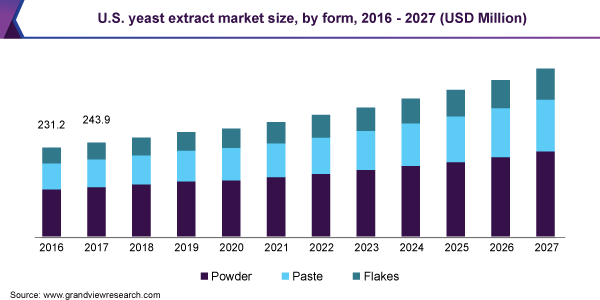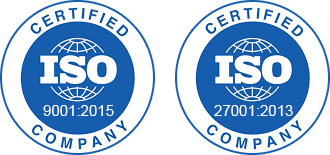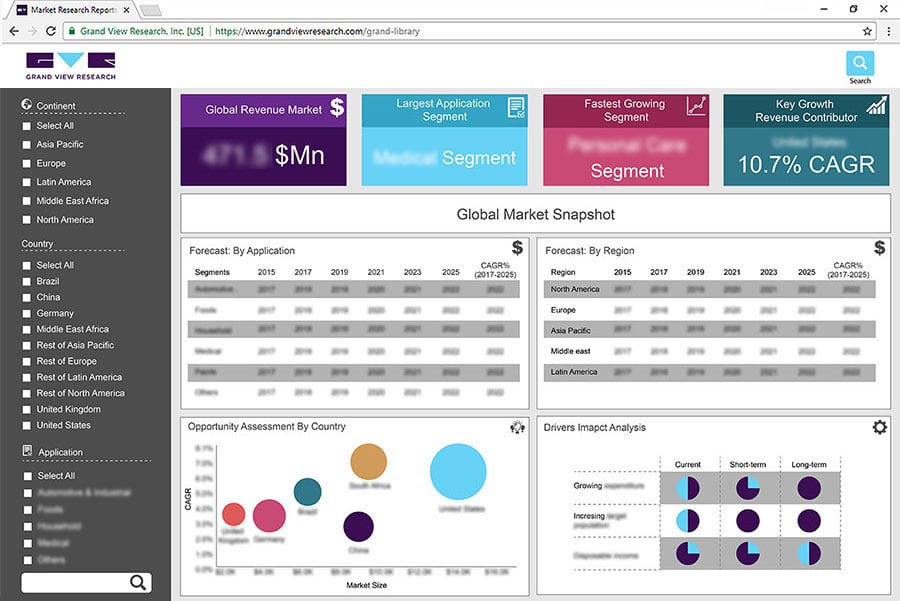- Home
- »
- Nutraceuticals & Functional Foods
- »
-
Global Yeast Extract Market Size, Industry Report, 2020-2027GVR Report cover
![Yeast Extract Market Size, Share & Trends Report]()
Yeast Extract Market Size, Share & Trends Analysis Report By Application (Animal Feed, Food & Beverages), By Technology (Autolyzed, Hydrolyzed), By Form, By Region, And Segment Forecasts, 2020 - 2027
- Report ID: GVR-4-68038-877-0
- Number of Report Pages: 150
- Format: PDF, Horizon Databook
- Historical Range: 2016 - 2018
- Forecast Period: 2020 - 2027
- Industry: Consumer Goods
Report Overview
The global yeast extract market size was valued at USD 1.3 billion in 2019 and is expected to grow a compound annual growth rate (CAGR) of 5.9% from 2020 to 2027. The upsurge in the consumption of alcoholic beverages and increasing demand for bakery food products are expected to propel the market growth. Yeast extract is a clean label ingredient. It is considered as a natural flavoring ingredient like spices and herbs. Among all its unique features, yeast extract is also GMO-free, Kosher, Halal, and generally does not contain gluten. Furthermore, rising consumer preference for healthy and fresh food products comprising natural ingredients is projected to drive its demand. The easy accessibility of resources, such as saccharides and other sugar derivatives, at a reasonable price is anticipated to boost the yeast extract market growth over the forecast period.

The market for bakery products is expected to increase over the projected period on account of new product development and innovations. The product is formed without any chemical additives with the help of enzymes that segregate the proteins in yeast into their taste-offering feature. These are removed from the insoluble residual constituents and dried.
The outcome of this method is yeast extract, a blend of distinguished carbohydrates, amino acids, minerals, and vitamins. According to the European Association for Specialty Yeast Products, increasing product development within the vegan/plant-based space and meat alternative are building a novel opportunity for the product to provide a clean label edge and savory flavor.
Technology Insights
The autolyzed technology segment accounted for the largest share of more than 55% in 2019. The segment will retain the dominant position throughout the forecast period on account of the distinguished taste of autolyzed yeast extracts in various food applications, such as bakery products, soups, and dressings. Such extracts are a rich source of micronutrients and vitamin B. Moreover, rising demand for natural food ingredients and clean label products are driving the autolyzed segment.
The autolyzed technique has low-cost features and a high extraction rate. The hydrolysis method, on the other hand, has a higher cost but is suitable for producing premium-quality products. Several technological innovations are developed, such as membrane ultrafiltration technology, flavored technology, and yeast cell wall breaking technology.
The flavor-enhancing technology is used to make flavored yeast extract by Maillard's reaction to generate a flavor of chicken, beef, and other meat flavors. Autolyzed yeast is usually formed by allowing the peptide bonds of the proteins in the yeast to hydrolyze. This is made by one of two distinguished methods. Edible yeast is heated under a tightly controlled environment to a temperature that makes proteolytic enzymes already present in the yeast to digest the proteins, and break their bonds, producing distinguished amino acids and peptides.
Form Insights
The powder form led the market accounting for the maximum share of more than 50% in 2019 and is expected to witness substantial gains in the future on account of its wide utilization in numerous applications, such as bakery & confectionery, meat, dairy, medicines, and dietary supplements. The powder form is a natural flavor enhancer or flavoring agent, which is used as a substitute to MSG. It is also used as nutrients for bacterial culture media.
The usage of the powdered product is much more convenient as compared to its paste form. The weighing of powdered products is moderately accurate; the addition is accessible, the cutting of the package can be discarded, and there is no difficulty of low fluidity of the product. For instance, 1 kg of yeast extract powder can commonly replace 1.5 kg yeast extract paste, which means the labor intensity is lower, the amount of material is smaller, and there is no need to clean the container, and is convenient for on-site administration.
Application Insights
Food & beverage segment dominated the market and held more than 38% of the global share in 2019. The product demand in the food & beverage sector is growing significantly owing to the rising cases of allergies caused due to MSG. The food & beverage application is anticipated to gain traction over the forecast period on account of extensive product usage in the fermentation of sugars in bakery applications.

Animal feed was the second-largest application segment in 2019. It is projected to register the fastest CAGR from 2020 to 2027 on account of rising product demand in this application segment sue to numerous health and nutritional benefits, such as improved animal productivity and efficiency and digestibility of feed along with reduced risks of acidosis. The product comprises several bio-active elements, including cell wall polysaccharides and nucleotides, which are measured as favorable to the gut health and growth of piglets. Therefore, it is estimated to be a potential in-feed antibiotic substitute.
Regional Insights
Europe was the dominant regional market in 2019 and accounted for a share of more than 36%. The growing demand for nutritional yeast extract and increased consumption of processed food are the major factors driving the market growth in this region. Changing lifestyle, growing urbanization, surge in consumer preference for natural ingredients, increasing demand for baked food products, and extensive usage of organic yeast extracts in the food & beverage applications are several other key factors boosting the regional market growth.
Moreover, rising demand for ready-to-eat food products due to shifting dietary preferences in will drive the regional market. The product is extensively used as natural ingredient, as a salt reduction ingredient, and as a flavoring agent in bakery items, canned and frozen soups, sauces, meat, and fish, and savory mixes. Asia Pacific is expected to register the highest CAGR over the forecast period. Countries like China and India exhibit growing product demand owing to consumer inclination for high-quality food and beverage products.
Key Companies & Market Share Insights
The market is aggressive, with companies undertaking some activities, including capital extension, strategic alliances, regular mergers, and acquisitions. Established companies are focusing on increasing their share in the overall industry and productivity through various technological innovations. Some of the prominent players in the yeast extract market include:
-
Lesaffre Group
-
Kerry Group
-
Angel Yeast
-
Leiber GmBH
-
Lallemand, Inc.
-
Biospringer
-
DSM
-
Synergy Flavors
-
Thai Foods International Co., Ltd.
-
Halcyon Proteins
-
Specialty Biotech
-
Alltech
-
Ohly
-
Kohjin Life Sciences
-
Sensient Technologies Corp.
-
AB Mauri
-
Biorigin
-
Titan Biotech Limited Company
-
Oriental Yeast
-
Kothari Fermentation & Biochem Ltd.
Yeast Extract Market Report Scope
Report Attribute
Details
Market size value in 2020
USD 1.4 Billion
Volume size in 2020
126.8 Kilotons
Revenue forecast in 2027
USD 2.1 Billion
Volume forecast in 2027
185.6 Kilotons
Growth Rate
CAGR of 5.9% from 2020 to 2027 (Revenue-based)
Base year for estimation
2019
Historical data
2016 - 2018
Forecast period
2020 - 2027
Quantitative units
Volume in Kilotons, Revenue in USD million, and CAGR from 2020 to 2027
Report coverage
Volume forecast, revenue forecast, company ranking, competitive landscape, growth factors, and trends
Segments covered
Technology, form, application, region
Regional scope
North America, Europe, Asia Pacific, South America, Middle East & Africa
Country scope
U.S., Canada, Mexico, U.K., Germany, France, Spain, China, Japan, India, Australia, Brazil, Argentina, South Africa
Key companies profiled
Lesaffre Group; Kerry Group; Angel Yeast; Leiber GmbH; Lallemand, Inc.; Biospringer; Synergy Flavors; Thai Foods International Co., Ltd.; Halcyon Proteins; Specialty Biotech; Alltech; Ohly; Kohjin Life Sciences; Sensient Technologies Corp.; AB Mauri; Biorigin; Titan Biotech Ltd Co.; Oriental Yeast; Kothari Fermentation & Biochem Ltd.
Customization scope
Free report customization (equivalent up to 8 analysts’ working days) with purchase. Addition or alteration to country, regional & segment scope
Pricing and purchase options
Avail customized purchase options to meet your exact research needs. Explore purchase options
Segments Covered in the ReportThis report forecasts volume and revenue growth at global, regional, and country levels and provides an analysis of the latest industry trends in each of the sub-segments from 2020 to 2027. For the purpose of this study, Grand View Research has segmented the global yeast extract market report on the basis of technology, form, application, and region:
-
Technology Outlook (Volume, Kilotons; Revenue, USD Million, 2016 - 2027)
-
Autolyzed
-
Hydrolyzed
-
-
Form Outlook (Volume, Kilotons; Revenue, USD Million, 2016 - 2027)
-
Powder
-
Paste
-
Flakes
-
-
Application Outlook (Volume, Kilotons; Revenue, USD Million, 2016 - 2027)
-
Food & Beverages
-
Animal Feed
-
Pharmaceuticals
-
Others
-
-
Regional Outlook (Volume, Kilotons; Revenue, USD Million, 2016 - 2027)
-
North America
-
The U.S.
-
Canada
-
Mexico
-
-
Europe
-
The U.K.
-
Germany
-
France
-
Spain
-
-
Asia Pacific
-
China
-
India
-
Japan
-
Australia
-
-
Central & South America
-
Brazil
-
Argentina
-
-
Middle East & Africa
-
South Africa
-
-
Frequently Asked Questions About This Report
b. The global yeast extract market size was estimated at USD 1.36 billion in 2019 and is expected to reach USD 1.39 billion in 2020.
b. The yeast extract market is expected to grow at a compound annual growth rate of 5.9% from 2020 to 2027 to reach USD 2.16 billion by 2027.
b. The powder form dominated the market share accounting for more than 50% in 2019 and is expected to witness substantial gains on account of its wide-ranging utilization in numerous applications such as sauces and dressing, bakery, and confectionery, soy, meat, dairy, medicines, and dietary supplements.
b. Some of the key players operating in the yeast extract market include Lesaffre Group, Kerry Group, Angel Yeast, Leiber GmBH, Lallemand, Inc, Biospringer, DSM, Synergy Flavors, Thai Foods International Co., Ltd, Halcyon Proteins, Specialty Biotech, Alltech, Ohly, Kohjin Life Sciences, Sensient Technologies Corporation, AB Mauri, Biorigin, Titan Biotech Limited Company, Oriental Yeast, and Kothari Fermentation & Biochem Ltd.
b. Key factors that are driving the yeast extract market includes the increasing demand for natural ingredients and clean label factors in the food & beverage industry. Furthermore, yeast extracts are a dominant substitute for MSG in the food & beverage industry, thereby is expected to increase market penetration over the projected period.
Share this report with your colleague or friend.
![gvr icn]()
NEED A CUSTOM REPORT?
We can customize every report - free of charge - including purchasing stand-alone sections or country-level reports, as well as offer affordable discounts for start-ups & universities. Contact us now
![Certified Icon]()
We are GDPR and CCPA compliant! Your transaction & personal information is safe and secure. For more details, please read our privacy policy.
We are committed towards customer satisfaction, and quality service.
"The quality of research they have done for us has been excellent."





